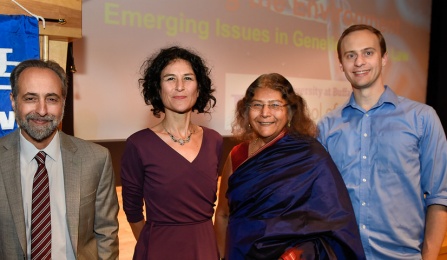
Guyora Binder (UB), Irus Braverman (UB), Sheila Jasanoff (Harvard), Kevin Esvelt (MIT)
Mitchell Lecture tackles technology’s ethical edge
Fall 2016 Mitchell Lecture
“Elegant editing of any living organism.” As described by Professor Irus Braverman, organizer of the 2016 Mitchell Lecture, that’s the promise of a new genetic engineering technology called CRISPR.
Using the technique, she said, genetic engineers claim that they can “snip out a piece of DNA at any point in the genome, then stitch ends back together seamlessly.” The result: numerous potential alterations in flora and fauna, including allergen-free peanuts, longer-lasting tomatoes, disease-resistant wheat and more muscular beagles.
But the technology comes with a host of ethical and legal issues, Braverman said. And it raises the prospect of an until-now uncrossed threshold: altering the human germline so that edited-in characteristics could be passed on to the next generations.
Two nationally renowned speakers addressed aspects of those ethical dilemmas at the October 21 Mitchell Lecture, the School of Law’s signature lecture series. Before a packed audience in the Screening Room of UB’s Center for the Arts, these speakers explored both the possibilities and the pitfalls that CRISPR and similar technologies pose for humanity. The event, part of a two-day conference, was titled “Editing the Environment: Emerging Issues in Genetics and the Law.”
Kevin M. Esvelt of the Massachusetts Institute of Technology is one of the leading scientists using CRISPR to develop what are called gene drive systems. CRISPR-based gene drives are unusual in that they would not only alter an individual organism but could swiftly modify entire populations and drive entire species to extinction by design.
Esvelt noted that the potential for doing good with gene drives is vast. “In the last two minutes, malaria has killed a child and infected 100 people. Suppose we can engineer mosquitoes not to carry pathogens?” Nonetheless, he argued for a cautious approach when applying gene drives to mosquito species, saying that one escaped organism lucky enough to find a mate has a reasonable chance of converting the local population and could then spread to every population of that species throughout the world. “The consequences for public opinion would be less than favorable,” he said.
Esvelt noted that much scholarly writing in the field addresses how to do such research safely and in a controlled way. “Probably a good rule of thumb is to introduce the smallest possible change that can solve the problem,” he said. “And we need to try it out in a small area, ideally contained, see what the effects might be, and then scale up only if it works.”
He also expressed his support for “local, open, responsive science,” a schema under which scientists openly share their proposals before experiments begin and consult with communities that are likely to be affected before beginning a gene drive research project.
Professor Sheila Jasanoff of Harvard University’s Kennedy School of Government was co-speaker at the event. Jasanoff emphasized how many unanswered issues remain to be addressed. “There are a lot of big, open questions from the standpoint of law and public policy,” she said. “Can we do it? Why do we think we can? Should we do it? What gets in the way? And whose responsibility is it to decide?”
Jasanoff, whose scholarly research explores the role of science and technology in the law, said that CRISPR researchers have long been governed by the assumption that the technology allows precise manipulation, that the consequences of gene editing are predictable, and that ideas of “containment” borrowed from the nuclear power industry are adequate safeguards.
Two paradigms have been applied to the way gene editing is governed, she said: one based on the risks involved, the other based on the rights of the individuals affected. Instead, she proposed a third framework: bio-constitutionalism. “It begins with the nature of the human subject,” Jasanoff said. “It focuses on relationships with oneself, with others and with institutions, and it focuses on what human beings want to be and do as humans.” Jasanoff concluded: “What has been left out of this discussion is what kinds of things, what kinds of entities, what kinds of properties do we want in the world?”
